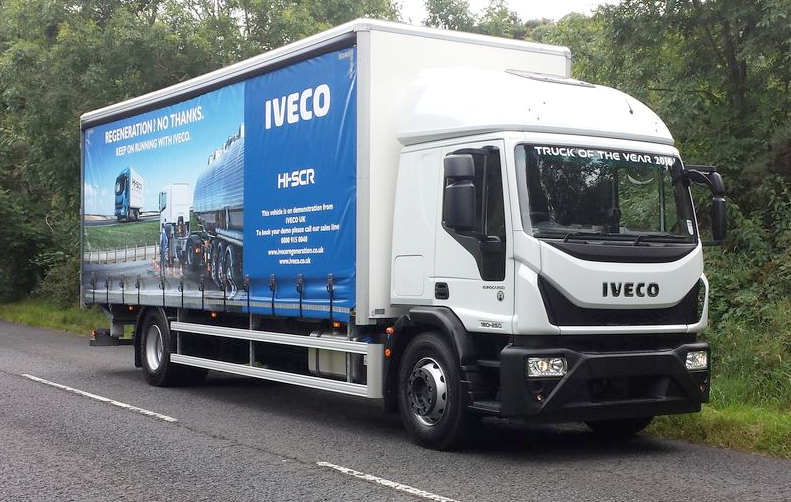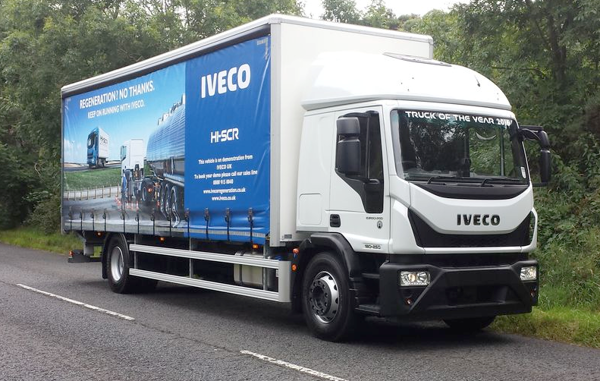Review
Award-winning, self-proclaimed ‘truck the city likes’ offers array of options and the 18-tonne version is a worthy sector competitor
Iveco has undergone many changes over the past few years, renewing its offerings across the product line-up from the ‘heavy end’ Stralis XP and the lighter 7.5-tonne Eurocargo which we tested last year. So this month we have gone to the other extreme and taken to the road in the 18-tonne version rigid – specifically the 180E25.
The range effectively starts around 7.5 tonnes gvw moving through virtually every major weight sector to the maximum two axle weight of 18 tonnes.
Under the marketing strapline of “the truck the city likes” the Eurocargo was proclaimed the International Truck of the Year for 2016 so Iveco must be doing something right and certainly the range is comprehensive, offering 11,000 factory versions according to Iveco.
As with most manufacturers, there is a large dividing line in product types around the 12-tonne gvw mark. In Iveco’s case this manifests itself in the switch from a one-step cab to a two-step and the 162PS power rating disappears with the higher cab.
The power unit for all is the familiar, albeit upgraded, Tector engine based on two engine blocks, either a four-cylinder 4.5-litre (Tector 5) or six cylinder 6.7-litre (Tector 7). Power ratings on the Tector 5 start at 162PS progressing through 193PS to the maximum 213PS, with the Tector 7 taking up the mantle at 223PS, 253PS and 284PS finishing at 324PS.
Interestingly, the torque range on both engines is completely different, with the smaller Tector 5 covering band from 680Nm to 750Nm (70Nm) while the Tector 7 covers 800Nm to 1100Nm (300Nm) out of proportion to the 51PS and 101PS range respectively.
Having said all that, the 18-tonne versions are only offered with the Tector 7 engines at all power ratings as the 213PS of the Tector 5 is considered underpowered.
One of main features of both engines is their exclusive use of Iveco’s Hi-SCR after-treatment system which is lighter compared to conventional EGR/SCR combinations and eliminates regeneration downtime compared with other Euro 6 vehicles.
Eurocargo operators are spoilt for choice of gearbox with five potential options ranging from a six- and nine-speed manual to six- or 12-speed automatic, and specialist applications have the added bonus of a five-speed automatic.
Iveco engineers have employed smart technology with an electronically-controlled two-speed electromagnetic fan clutch which engages or disengages according to the cooling needs. Further fuel saving features include EcoRoll, introduced on the 12-speed gearbox, which takes advantage of the vehicle’s inertia and automatically shifts the gearbox in and out of neutral to reduce fuel consumption when appropriate, such as when descending a hill.
This is enhanced by an ‘EcoSwitch’ available on all six- to 12-speed auto gearboxes. It’s activated by the driver, and re-programmes the gear change logic for maximum efficiency by activating the speed limiter, deactivating the kick-down function, and only authorises automatic gear changes.
Suspension systems choices are traditional, comprising parabolic, semi-elliptical leaf spring and air suspensions controlled by an ECaS (electronically controlled air suspension) system, which guarantees a constant vehicle position regardless of the load level. While rear air is available across the heavier Eurocargo range, front air suspension is not an option on the heaviest 18-tonne derivative.
There are eight wheelbases starting at the tipper-friendly 3,690mm to the more haulage style 6,570mm with all the 18-tonne models having air brakes-supported engine braking via an exhaust valve on the Hi-SCR Tector engine.
Under the ‘driver assist’ banner, Iveco has a suite of technology-based safety features, some are legally required but others are product benefits to the operator that have become familiar in a modern family car.
Lane departure warning uses a windscreen-mounted camera, enabling the system to recognise the road markings and will sound an alarm if the vehicle changes lane without the driver signalling. Electronic vehicle stability control is supplemented by the advanced emergency braking system (AEBS) which measures the distance from the vehicle in front, and calculates the time remaining to take action before a potential collision. A double warning system is triggered before the brakes are applied automatically reducing the speed to 20mph (32kph) to avoid impact. In the case of a fixed obstacle, the system can prevent and moderate the impact by reducing the speed by 6mph.
Finally, adaptive cruise control adjusts the speed by maintaining the distance from the vehicle in front via the AEBS radar, automatically reducing torque, then the engine brake and, finally, the service brake.
There are four cab types, starting with a day cab, two sleeper cabs (with two roof height options) and a six passenger (plus driver) crew cab with a standard low roof.
For our road test we choose the Tector 7 253PS two-step sleeper cab with a curtainside body from West Midlands-based bodybuilder JC Payne.
The front cab and ‘smiley’ grille design is probably one of the best facelifts on the market. While this doesn’t add to the operating efficiency it helps provides a more sympathetic appearance which is important for a distribution vehicle.
The 18-tonne version is considerably larger than its 7.5-tonne sibling and this is apparent as you step up into the cab which has a floor height around 1.1m, on a par with direct competitors.
Once inside, the driver’s air-suspended seat with integral head restraint and safety belt settle you in quickly with particularly good support on the seat.
Facing the driver are the standard dials and gauges placed in the central instrument panel. To the left is the central binnacle with a large selection of switches and the rotary heating/ventilation controls are underneath with the simple three button drive system also housed in this area.
The instruments light up like a Christmas tree on start-up, reminiscent of the old Iveco Control System. But everything soon cools down and there’s no excessive noise from the Tector engine, making for a pleasant cab environment.
Pulling away you notice the large mirrors offering great visibility aided by the large windows as well as the optional CLOCS-style bottom window panel on the passenger’s side. The auto gearbox shifts up effortlessly although the shift down can just ‘hesitate’ as it looks for the right gear. But this happened only a couple times on our three-hour route.
While the paperwork says the Tector 7 253PS maximum torque of 850Nm is developed at 1,250rpm, on manual it went down to almost a 1,000rpm and picked up without hesitation. Staying within the green zone was a doddle throughout the mixture of urban and dual carriageway certainly helping to maintain the fuel economy.

















